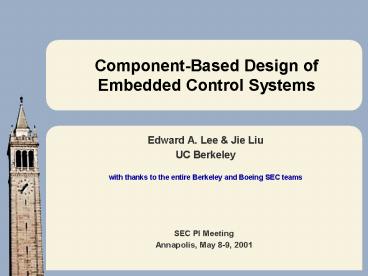ComponentBased Design of Embedded Control Systems PowerPoint PPT Presentation
1 / 21
Title: ComponentBased Design of Embedded Control Systems
1
Component-Based Design of Embedded Control Systems
- Edward A. Lee Jie Liu
- UC Berkeley
- with thanks to the entire Berkeley and Boeing SEC
teams
2
Precise Mode Change Problem
thread or process
thread or process
How do you get the processes to a quiescent state
to take a mode change?
thread or process
3
Components and their Relationships
An abstract syntax - clustered graphs - is well
suited to a wide variety of component-based
modeling strategies, ranging from state machines
to process networks.
4
Actor View of Producer/Consumer Components
- Producer/consumer styles
- continuous-time
- dataflow
- discrete events
- synchronous
- time-driven
- publish/subscribe
5
A Laboratory for Exploring Models of Computation
- Ptolemy II Java based, network integrated
- A realization of a model of computation is called
a domain. Multiple domains can be mixed
hierarchically in the same model.
6
Basic Object Model forExecutable Components
7
Abstract Semantics How Components Interact
- flow of control
- Initialization
- Execution
- Finalization
- communication
- Structure of signals
- Send/receive protocols
8
Abstract Semantics How Components Interact
- flow of control
- Initialization
- Execution
- Finalization
- communication
- Structure of signals
- Send/receive protocols
- preinitialize()
- declare static information, like type
constraints, scheduling properties, temporal
properties, structural elaboration - initialize()
- initialize variables
9
Abstract Semantics How Components Interact
- flow of control
- Initialization
- Execution
- Finalization
- communication
- Structure of signals
- Send/receive protocols
- iterate()
10
Abstract Semantics How Components Interact
- flow of control
- Initialization
- Execution
- Finalization
- communication
- Structure of signals
- Send/receive protocols
- iterate()
- prefire()
- fire()
- postfire()
- stopFire()
11
The Key Action Methods
- Prefire()
- obtain required resources
- may read inputs
- may start computations
- returns a boolean indicating readiness
- Fire()
- produces results
- Postfire()
- commits state updates (transactional)
- StopFire()
- request premature termination
- All of these are atomic (non-preemptible)
12
This Abstract Semanticshas Worked For
- Continuous-time models
- Finite state machines
- Dataflow
- Discrete-event systems
- Synchronous/reactive systems
- Time-driven models (Giotto)
- Can we make it work for priority-driven
multitasking (RTOS style)?
Hybrid systems
13
Benefits
- Composable semantics
- arbitrarily deep hierarchies
- heterogeneous hierarchies
- Precise mode switching
- nest FSMs with anything else
controller
plant
actuator
sensor
task2
dynamics
task1
TTA
TTA
Hierarchical, heterogeneous, system-level model
14
RTOS Domain
- Objective
- understand and improve OCP semantics
- support priority-driven preemptive scheduling
- use atomic execution, to get composability
- solve the precise mode change problem
- Solution
- Atomic execution when possible
- Façade to long-running processes when not
15
Atomic Façade to Long-Running Computations
- Each component defines the interaction between
the atomic façade and the long-running process. - There are several useful patterns
- allow task to complete
- enforce declared timing
- anytime computation
- transactional
16
RTOS Domain Implementation
- priority
- executionTime
RT-Q
(clock, 1.0)
(clock, 2.0)
(actor, output time)
(T3, p3, t3)
(T1, p1, t1)
OS-Q
(T1, p2, t2)
(task, priority, remaining processing time)
17
Example two simple tasks
nonpreemptive
preemptive
18
Inter-domain example shared-resource controllers
computer
plant1
controller1
plant2
controller2
19
Background process exampleData acquisition and
processing
background processes
atomic
20
What a Modal Control System Might Look Like
RTOS model
RTOS model
RTOS model
21
Conclusion
- Systematic, principled, real-time,
heterogeneous, hierarchical composition of - Processes and/or threads
- Finite automata (mode controllers)
- Other models of computation
- Continuous-time models
- Dataflow models
- The key is the abstract semantics of Ptolemy II,
which defines hierarchical heterogeneous
composition of models of computation.

